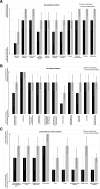Paediatric Physiotherapy curriculum: an audit and survey of Australian entry-level Physiotherapy programs
- PMID: 30992074
- PMCID: PMC6469150
- DOI: 10.1186/s12909-019-1540-z
Paediatric Physiotherapy curriculum: an audit and survey of Australian entry-level Physiotherapy programs
Abstract
Background: No documented standard or core competencies exist for paediatric curriculum in entry-level physiotherapy programs in Australia. Consequently, extensive variability is thought to exist amongst Australian entry-level physiotherapy programs for preparing physiotherapists to work safely and effectively with children. The purpose of this study was to explore the landscape of paediatric curriculum in Australian entry-level physiotherapy programs and identify the paediatric content being covered, its perceived importance according to university academics who teach paediatrics, the mode of delivery and assessment, and the strengths, weaknesses, barriers and facilitators to implementing paediatric curriculum.
Methods: A web-based desktop audit and an online cross-sectional survey using closed and open-ended questions was administered to all Australian universities offering entry-level physiotherapy programs in November 2017. Content coverage and perceived level of importance for paediatric content areas were determined using Likert scale responses. Open-ended responses were thematically analysed to identify key themes for strengths, weaknesses and facilitators to implementation of paediatric curriculum.
Results: All (n = 20, 100%) entry-level programs used the terms lifespan, child and/or paediatrics somewhere in at least one subject descriptor. Forty-five percent (n = 9) of universities did not use the terms lifespan, child or paediatric in their published learning objectives. Eight (40%) universities offered a paediatric stand-alone course. Sixty-five (13/20) percent of universities invited, responded to the survey. For paediatric conditions the perceived level of importance was predominately higher than its course content coverage for 19 of the 31 conditions surveyed. Key barriers to implementating paediatric curriculum were: crowded curriculum, limited financial resources resulting in a lack of qualified staff, lack of prioritisation of paediatric curriculum and inadequate paediatric placement availability. Facilitators for effective implementation of paediatric content were stand-alone paediatric subjects, demonstrated dedication to paediatric curriculum and having suitably qualified faculty members.
Conclusion: The results of this survey provide the physiotherapy community with the views of paediatric physiotherapy academic educators regarding the content, perceived need to expand content delivery in identified clinical areas, and the barriers and facilitators to implementing paediatric content in Australian entry-level physiotherapy programs. Further research exploring similar questions with paediatric physiotherapy clinicians would complement the findings of this study.
Keywords: Allied health; Australian; Curriculum; Entry-level; Paediatric; Physiotherapy; Tertiary education; Training; University.
Conflict of interest statement
Ethics approval and consent to participate
Ethical approval was provided by Bond University Human Research Ethics Committee; experimental protocol number (RO16162). All participants provided informed written consent obtained from Survey Monkey prior to their participation in the study.
Consent for publication
Informed consent was obtained from staff overlooking paediatric curriculum participating in this study. Consent was not obtained to publish any individual person’s data, details, images or videos and are therefore not being considered for publication in this manuscript.
Competing interests
The authors declare that they have no competing interests.
Publisher’s Note
Springer Nature remains neutral with regard to jurisdictional claims in published maps and institutional affiliations.
Figures



Similar articles
-
Fostering cultural responsiveness in physiotherapy: curricula survey of Australian and Aotearoa New Zealand physiotherapy programs.BMC Med Educ. 2019 Aug 30;19(1):326. doi: 10.1186/s12909-019-1766-9. BMC Med Educ. 2019. PMID: 31470833 Free PMC article.
-
The paediatric physiotherapy curricula landscape: A survey of United Kingdom entry-level programs.Physiother Res Int. 2023 Oct;28(4):e2012. doi: 10.1002/pri.2012. Epub 2023 May 13. Physiother Res Int. 2023. PMID: 37177822
-
The current state of pain education within Canadian physiotherapy programs: a national survey of pain educators.Disabil Rehabil. 2020 May;42(9):1332-1338. doi: 10.1080/09638288.2018.1519044. Epub 2019 Jan 8. Disabil Rehabil. 2020. PMID: 30620223
-
The degree to which physiotherapy literature includes physical activity as a component of health promotion in practice and entry level education: a scoping systematic review.Physiother Theory Pract. 2014 Jan;30(1):12-9. doi: 10.3109/09593985.2013.783896. Epub 2013 Jun 28. Physiother Theory Pract. 2014. PMID: 23808941
-
Moving Toward Excellence in Pediatric Physical Therapy Education: A Scoping Review.Pediatr Phys Ther. 2019 Jan;31(1):95-113. doi: 10.1097/PEP.0000000000000549. Pediatr Phys Ther. 2019. PMID: 30507855
Cited by
-
A step in the right direction: Delphi consensus on a UK and Australian paediatric podiatry curriculum.BMC Med Educ. 2022 Feb 24;22(1):125. doi: 10.1186/s12909-022-03138-8. BMC Med Educ. 2022. PMID: 35209896 Free PMC article.
-
Understanding the Perspectives of Paediatric Physicians on Physiotherapy in Paediatric Rehabilitation in Chennai, India: A Qualitative Approach.J Prev Med Public Health. 2024 Mar;57(2):157-166. doi: 10.3961/jpmph.23.426. Epub 2024 Jan 21. J Prev Med Public Health. 2024. PMID: 38374710 Free PMC article.
-
Physiotherapy and related management for childhood obesity: A systematic scoping review.PLoS One. 2021 Jun 14;16(6):e0252572. doi: 10.1371/journal.pone.0252572. eCollection 2021. PLoS One. 2021. PMID: 34125850 Free PMC article.
References
-
- Kruger J. Patient referral and the physiotherapist: three decades later. Aust Physiother Assoc. 2010;56:217–218. - PubMed
-
- APC. Accreditation Standards for Entry-Level Physiotherapy Practitioner Programs 2017 [Available from: https://physiocouncil.com.au.
-
- Melbourne RCH . RCH Physiotherapy : what is Physiotherapy? 2018.
-
- ABS. 3101.0 - Australian Demographic Statistics 2017 [Available from: http://www.abs.gov.au/ausstats/abs@.nsf/0/1CD2B1952AFC5E7ACA257298000F2E....
Publication types
MeSH terms
LinkOut - more resources
Full Text Sources
Medical

